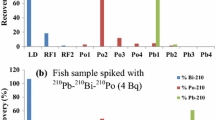Abstract
o-Tyrosine is proposed as a marker for the identification of irradiated protein-rich food. The disadvantages of most of the published methods are insufficient selectivity and the relatively high values of o-tyrosine in unirradiated samples. A method for the analysis of non-protein-bound o-tyrosine in common shrimps is presented here. The procedure involves the homogenization of fresh shrimps followed by solvent precipitation of the proteins with acetone and measurement of the free o-tyrosine by high-performance liquid chromatography with fluorescence detection. The separation is performed using two different separation systems: one based on an acidic eluent and one, used as a reference system, based on a basic eluent. Validation was carried out using a matrix calibration. In unirradiated shrimps a background level of 19.3±7.0 μg/kg (fresh weight) o-tyrosine was found. The content in irradiated shrimps (1 kGy) exceeded the background level by more than 10 times. The radiation dose-response curve was almost linear up to 5 kGy. A survey of the contents of a small market basket was carried out to prove the applicability of the developed method. None of the 11 analysed samples had an o-tyrosine content above the background level.
Similar content being viewed by others
Author information
Authors and Affiliations
Additional information
Received: 23 March 1999 / Revised version: 8 June 1999
Rights and permissions
About this article
Cite this article
Hein, W., Simat, T. & Steinhart, H. Detection of irradiated food . Eur Food Res Technol 210, 299–304 (2000). https://doi.org/10.1007/s002179900069
Issue Date:
DOI: https://doi.org/10.1007/s002179900069




